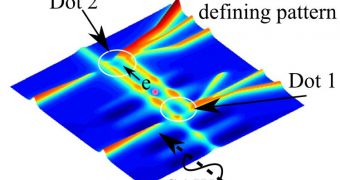A group of investigators at the University of Cambridge announces the development of a new control technique that allows physicists to monitor and influence the most fundamental aspect of any electronic circuit, which is the way in which individual electrons move through it.
The amazing degree of control the team demonstrated is detailed in a research paper published in the September 22 issue of the top scientific journal Nature. The work was led by experts from the Cambridge Cavendish Laboratory.
Scientists here were able to control the movements of a single electron in a wire, forcing it to move back and forth through its “prison” six times. This is a new record, far exceeding any other capabilities demonstrated so far.
According to researchers, the new achievement could bear significant implications for the field of quantum computing, where quantum bits called qubits are transferred regularly from memory to processor, and vice-versa.
“Imagine you are at a party and you want to get to the other side of a crowded room to talk to someone. As you walk you have to weave around people who are walking, dancing or just standing in the way,” the Cambridge team explains.
“You may also have to stop and greet friends along the way and by the time you reach the person you wanted to talk to you have forgotten what you were going to say. Wouldn’t it be nice to be lifted up above the crowd, and pushed directly to your destination?” the researchers add.
When applying this line of reasoning to electrons, the delays and zig-zag-type motions have a very bad effect, which is why they rip the electrons out of their quantum states, making them lose coherence. Needless to say, this must be prevented at all costs, if we are to develop quantum computers.
In the new study, the team used quantum dots as electron traps. The dots are placed inside a layer of gallium arsenide (GaAs), and connected through channels with a higher energy than the electron itself.
As the elementary particle is stuck in the pit, sound waves are directed through the channels, dispersing electrical potential that picks up the electron. The particle is swept to the next quantum dot, which is located about 4 microns away.
When another short burst of sound (only several billionths of a second long) is sent from the opposite direction, the dislodged potential again carries the electron to its former quantum dot. In this manner, experts managed up to 60 position changes before the system was compromised.
“The movement of electrons by our ‘surface acoustic wave’ can also be likened to peristalsis in the esophagus, where food is propelled from the mouth to the stomach by a wave of muscle contraction,” PhD student Rob McNeil explains. He did most of the work on the new study.
He and postdoctoral researcher Masaya Kataoka, who are both based at the Cambridge Department of Physics Cavendish Laboratory, worked together with team leader Chris Ford. The latter holds an appointment with the Semiconductor Physics Group at the Lab.
“This is an enabling technology for quantum computers. There is a lot of work going on worldwide to make this new type of computer, which may solve certain complex problems much faster than classical computers,” Ford explains.
“However, little effort has yet been put into connecting up different components, such as processor and memory. Although our experiments do not yet show that electrons ‘remember’ their quantum state, this is likely to be the case,” he concludes.
Nature doi: 10.1038/nature10444

 14 DAY TRIAL //
14 DAY TRIAL //